Comparison of Measurement Possibilities by Non-Invasive Reflectometric Sensors and Invasive Probes
Abstract
1. Introduction
2. Materials and Methods
2.1. Materials
2.1.1. TDR Meter Description
2.1.2. FP/Mts Sensor
2.1.3. Non-Invasive TDR Sensors
2.1.4. S1 Non-Invasive Sensor
2.1.5. S2 Non-Invasive Sensor
2.2. Description of the Tested Material
2.3. Samples and Preparations
2.3.1. Samples for Invasive Measurements
2.3.2. Samples for Non-Invasive Measurements
2.4. Methods
Description of the Measurement Procedure
2.5. Data Analysis Method
3. Results
4. Discussion
4.1. Regression Model
4.2. Uncertainty Analysis
4.3. Discussion of the Calibration Results and Uncertainty Calculations
5. Conclusions
Author Contributions
Funding
Institutional Review Board Statement
Informed Consent Statement
Data Availability Statement
Conflicts of Interest
References
- Bobociński, A. Wpływ wilgotności sorpcyjnej na przewodność cieplną betonów komórkowych. Pr. Inst. Tech. Bud. 2003, 32, 35–47. [Google Scholar]
- Dutkiewicz, J.; Górny, R.L. Biologiczne Czynniki Szkodliwe Dla Zdrowia–Klasyfikacja i Kryteria Oceny Narażenia. Med. Pr. 2002, 53, 29–39. [Google Scholar] [PubMed]
- Ważny, J.; Karyś, J. Ochrona Budynków Przed Korozją Biologiczną: Praca Zbiorowa.; Arkady: Warsaw, Poland, 2001; ISBN 83-213-4205-1. [Google Scholar]
- Wiszniewska, M.; Walusiak, J.; Gutarowska, B.; Żakowska, Z.; Pałczyński, C. Grzyby Pleśniowe w Środowisku Komunalnym i w Miejscu Pracy—Istotne Zagrożenia Zdrowotne. Med. Pr. 2004, 55, 257–266. [Google Scholar] [PubMed]
- Orlik-Kożdoń, B.; Steidl, T.; Rubim, J.A. Wybrane Problemy Związane z Termoizolacją Ścian Budynków Zabytkowych. Izolacje 2018, 23, 36–40. [Google Scholar]
- Guz, Ł.; Sobczuk, H. Water Potential Measurement in Porous Materials with Peltier Psychrometer. 2008. Available online: https://www.researchgate.net/publication/262674645_Water_potential_measurement_in_porous_materials_with_Peltier_psychrometer (accessed on 12 December 2022).
- Monczyński, B. Diagnostyka Zawilgoconych Konstrukcji Murowych. Izolacje 2019, 24, 89–93. [Google Scholar]
- Buczkowski, W.; Wiśniewska, J.; Żelazny, R. Analiza porównawcza wyników pomiarów wilgotności uzyskiwanych przy zastosowaniu różnych metod i przyrządów. Apar. Badaw. I Dydakt. 2003, 8, 16–22. [Google Scholar]
- Wiebe, H.H.; Campbell, G.S.; Gardner, W.H.; Rawlins, S.L.; Cary, J.W.; Brown, R.W. Measurement of Plant and Soil Water Status. Available online: https://eprints.nwisrl.ars.usda.gov/id/eprint/1250/ (accessed on 30 September 2022).
- Marten, J. Methods of Measuring the Moisture Diffusivity at High Moisture Levels. Bachelor’s Thesis, Lund Unversity, Lund, Sweden, 1997. [Google Scholar]
- Suchorab, Z.; Majerek, D.; Koci, V.; Cerny, R. Time Domain Reflectometry Flat Sensor for Non-Invasive Monitoring of Moisture Changes in Building Materials. Measurement 2020, 165, 108091. [Google Scholar] [CrossRef]
- Maser, K. Integration of Ground Penetrating Radar and Infrared Thermography for Bridge Deck Condition Evaluation. In Proceedings of the NDTCE’09, Non-Destructive Testing in Civil Engineering Conference, Nantes, France, 30 June–3 July 2009; p. 8. [Google Scholar]
- Maldague, X.P.V. Nondestructive Evaluation of Materials by Infrared Thermography; Springer: Berlin/Heidelberg, Germany, 1993; ISBN 978-1-4471-1995-1. [Google Scholar]
- Vollmer, M.; Mollmann, K.-P. Infrared Thermal Imaging: Fundamentals, Research and Applications, 2nd ed.; Wiley: Hoboken, NJ, USA, 2018; ISBN 978-3-527-41351-5. [Google Scholar]
- Trochonowicz, M.; Witek, B.; Chwiej, M. Impact analysis of humidity and temperature on the value of thermal conductivity λ coefficient of insulating materials used inside buildings in polish. Bud. I Archit. 2013, 12, 165–176. [Google Scholar] [CrossRef]
- Pasierb, B. Techniki Pomiarowe Metody Elektrooporowej. Środowisko 2012, 109, 191–199. [Google Scholar]
- Farahiyah, D.; Purnama, B.W. Design Prototype of Temperature and Humidity Control and Monitoring on Weaver Ant Cage Based on Internet of Things. J. Ilm. Tek. Elektro Komput. Dan Inform. 2021, 7, 326–337. [Google Scholar] [CrossRef]
- Bogdan, M. How to Use the DHT22 Sensor for Measuring Temperature and Humidity with the Arduino Board. Acta Univ. Cibiniensis. Tech. Ser. 2016, 68, 22–25. [Google Scholar] [CrossRef]
- Łobzowski, A.; Opęchowski, A.; Szkolnikowski, W. Pomiar Wilgotności Gleby, Materiałów Stałych i Sypkich. POMIAR 2008, 4. Available online: https://www.label.pl/po/wilgotn_mater_stalych.html (accessed on 12 December 2022).
- Lin, C.-P. Frequency Domain versus Travel Time Analyses of TDR Waveforms for Soil Moisture Measurements. Soil Sci. Soc. Am. J. 2003, 67, 720–729. [Google Scholar] [CrossRef]
- Suchorab, Z.; Tabiś, K.; Brzyski, P.; Szczepaniak, Z.; Rogala, T.; Susek, W.; Łagód, G. Comparison of the Moist Material Relative Permittivity Readouts Using the Non-Invasive Reflectometric Sensors and Microwave Antenna. Sensors 2022, 22, 3622. [Google Scholar] [CrossRef]
- Liu, Q.; Zhou, J. Research on Microwave Humidity Testing of Ceramic Products. J. Wuhan Univ. Technol.-Mater. Sci. Ed. 2000, 15, 45–48. [Google Scholar]
- Oliveira, J.G.D.; Junior, J.G.D.; Pinto, E.N.M.G.; Neto, V.P.S.; D’Assunção, A.G. A New Planar Microwave Sensor for Building Materials Complex Permittivity Characterization. Sensors 2020, 20, 6328. [Google Scholar] [CrossRef]
- Adhiwibowo, W.; Daru, A.F.; Hirzan, A.M. Temperature and Humidity Monitoring Using DHT22 Sensor and Cayenne API. J. Transform. 2020, 17, 209–214. [Google Scholar] [CrossRef]
- Gąsiorski, A.; Posyłek, Z.; Dróżdż, T. Mikrofalowa metoda określania wilgotności lignocelulozowych paliw stałych. Electrotech. Rev. 2015, 1, 101–103. [Google Scholar] [CrossRef]
- Brown, A.; Yardley, R.; Quincey, P.; Butterfiels, D. Studies of the Effect of Humidity and Other Factors on Some Different Filter Materials Used for Gravimetric Measurements of Ambient Particulate Matter. Atmos. Environ. 2006, 40, 4670–4678. [Google Scholar] [CrossRef]
- Trochonowicz, M.; Szostak, B.; Lisiecki, D. Analiza porównawcza badań wilgotnościowych metodą chemiczną w stosunku do badań grawimetrycznych wybranych materiałów budowlanych. Bud. I Archit. 2016, 15, 163–171. [Google Scholar] [CrossRef]
- Hola, A. Measuring of the Moisture Content in Brick Walls of Historical Buildings—The Overview of Methods. IOP Conf. Ser. Mater. Sci. Eng. 2017, 251, 012067. [Google Scholar] [CrossRef]
- Trochonowicz, M.; Szostak, B.; Lackorzyński, M. Accuracy of the CM Carbide Method When Testing Counter-Floors Used in the Construction Industry. Civ. Environ. Eng. Rep. 2020, 30, 64–73. [Google Scholar] [CrossRef]
- Chow, T.L.; Vries, J. de Dynamic Measurement of Soil and Leaf Water Potential with a Double Loop Peltier Type Thermocouple Psychrometer. Soil Sci. Soc. Am. J. 1973, 37, 181–188. [Google Scholar] [CrossRef]
- Guz, Ł.; Sobczuk, H. Badanie Potencjału Wody w Materiałach Budowlanych za Pomocą Sondy Psychrometrycznej. Proc. ECOpole 2008, 2, 185–190. [Google Scholar]
- Calamita, G.; Brocca, L.; Perrone, A.; Piscitelli, S.; Lapenna, V.; Melone, F.; Moramarco, T. Electrical Resistivity and TDR Methods for Soil Moisture Estimation in Central Italy Test-Sites. J. Hydrol. 2012, 454–455, 101–112. [Google Scholar] [CrossRef]
- Hailong, H.; Kailin, A.; Min, L.; Jinghui, X.; Wenyi, S.; Jones, S.; Gonzalez-Teruel, J.; Robinson, D.; Horton, R.; Bristow, K.; et al. A Review of Time Domain Reflectometry (TDR) Applications in Porous Media. Adv. Agron. 2021, 168, 83–155. [Google Scholar] [CrossRef]
- Krishnapillai, M.; Ranjan, R.S. Non-destructive Monitoring of Nitrate Concentration in a Laboratory Flow Experiment Using Time Domain Reflectometry (TDR). Environ. Technol. 2008, 30, 101–109. [Google Scholar] [CrossRef]
- Topp, G.C.; Davis, J.L. Measurement of Soil Water Content Using Time-Domain Reflectrometry (TDR): A Field Evaluation. Soil Sci. Soc. Am. J. 1985, 49, 19–24. [Google Scholar] [CrossRef]
- Goetzke-Pala, A.; Hoła, J. Testing of the moisture content of saline brick walls using the non-destructive microwave method in polish. Mater. Bud. 2016, 9, 104–106. [Google Scholar] [CrossRef]
- Gorzelańczyk, T.; Schabowicz, K. Nieniszczące badania wilgotności płyt włóknisto-cementowych metodą dielektryczną; Non-destructive testing of fiber cement board moisture using dielectric method. Weld. Technol. Rev. 2014, 86, 1. [Google Scholar] [CrossRef]
- Bi, H.; Yin, K.; Xie, X.; Ji, J.; Wan, S.; Sun, L.; Terrones, M.; Dresselhaus, M.S. Ultrahigh Humidity Sensitivity of Graphene Oxide. Sci. Rep. 2013, 3, 2714. [Google Scholar] [CrossRef]
- Leciejewski, P. Wykorzystanie Metody TDR Do Ciaglego Pomiaru Zmian Warunkow Wilgotnosciowych i Termicznych w Profilu Glebowym. Stud. I Mater. Cent. Edukac. Przyr.-Leśnej 2009, 11, 235–246. [Google Scholar]
- Mojid, M.A.; Cho, H. Evaluation of the Time-Domain Reflectometry (TDR)-Measured Composite Dielectric Constant of Root-Mixed Soils for Estimating Soil-Water Content and Root Density. J. Hydrol. 2004, 295, 263–275. [Google Scholar] [CrossRef]
- Watanabe, K.; Wake, T. Measurement of Unfrozen Water Content and Relative Permittivity of Frozen Unsaturated Soil Using NMR and TDR. Cold Reg. Sci. Technol. 2009, 59, 34–41. [Google Scholar] [CrossRef]
- Suchorab, Z.; Widomski, M.; Łagód, G.; Barnat-Hunek, D.; Majerek, D. A Noninvasive TDR Sensor to Measure the Moisture Content of Rigid Porous Materials. Sensors 2018, 18, 3935. [Google Scholar] [CrossRef] [PubMed]
- Suchorab, Z.; Malec, A.; Sobczuk, H.; Łagód, G.; Gorgol, I.; Łazuka, E.; Brzyski, P.; Trník, A. Determination of Time Domain Reflectometry Surface Sensors Sensitivity Depending on Geometry and Material Moisture. Sensors 2022, 22, 735. [Google Scholar] [CrossRef] [PubMed]
- Barnat-Hunek, D.; Smarzewski, P.; Suchorab, Z. Effect of Hydrophobisation on Durability Related Properties of Ceramic Brick. Constr. Build. Mater. 2016, 111, 275–285. [Google Scholar] [CrossRef]
- Majcher, J.; Kafarski, M.; Wilczek, A.; Szypłowska, A.; Lewandowski, A.; Woszczyk, A.; Skierucha, W. Application of a Dagger Probe for Soil Dielectric Permittivity Measurement by TDR. Measurement 2021, 178, 109368. [Google Scholar] [CrossRef]
- Brzyski, P.; Suchorab, Z. Capillary Uptake Monitoring in Lime-Hemp-Perlite Composite Using the Time Domain Reflectometry Sensing Technique for Moisture Detection in Building Composites. Materials 2020, 13, 1677. [Google Scholar] [CrossRef]
- Skierucha, W.; Wilczek, A.; Alokhina, O. Calibration of a TDR Probe for Low Soil Water Content Measurements. Sens. Actuators A Phys. 2008, 147, 544–552. [Google Scholar] [CrossRef]
- Guide to the Expression of Uncertainty in Measurement—Part 6: Developing and Using Measurement Models; Joint Committee for Guides in Metrology: Sevres, France, 2020; p. 103.
- Topp, G.C.; Davis, J.L.; Annan, A.P. Electromagnetic Determination of Soil Water Content: Measurements in Coaxial Transmission Lines. Water Resour. Res. 1980, 16, 574–582. [Google Scholar] [CrossRef]
- Roth, K.; Schulin, R.; Flühler, H.; Attinger, W. Calibration of Time Domain Reflectometry for Water Content Measurement Using a Composite Dielectric Approach. Water Resour. Res. 1990, 26, 2267–2273. [Google Scholar] [CrossRef]
- Udawatta, R.P.; Anderson, S.H.; Motavalli, P.P.; Garrett, H.E. Calibration of a Water Content Reflectometer and Soil Water Dynamics for an Agroforestry Practice. Agrofor. Syst. 2011, 82, 61–75. [Google Scholar] [CrossRef]
- TOPP, G.C.; ZEBCHUK, W.D.; DAVIS, J.L.; BAILEY, W.G. The Measurement of Soil Water Content Using a Portable Tdr Hand Probe. Can. J. Soil. Sci. 1984, 64, 313–321. [Google Scholar] [CrossRef]
- Amato, M.; Ritchie, J.T. Small Spatial Scale Soil Water Content Measurement with Time-Domain Reflectometry. Soil Sci. Soc. Am. J. 1995, 59, 325–329. [Google Scholar] [CrossRef]
- Černý, R. Time-Domain Reflectometry Method and Its Application for Measuring Moisture Content in Porous Materials: A Review. Measurement 2009, 42, 329–336. [Google Scholar] [CrossRef]
- Malicki, M.A.; Plagge, R.; Roth, C.H. Improving the Calibration of Dielectric TDR Soil Moisture Determination Taking into Account the Solid Soil. Eur. J. Soil Sci. 1996, 47, 357–366. [Google Scholar] [CrossRef]
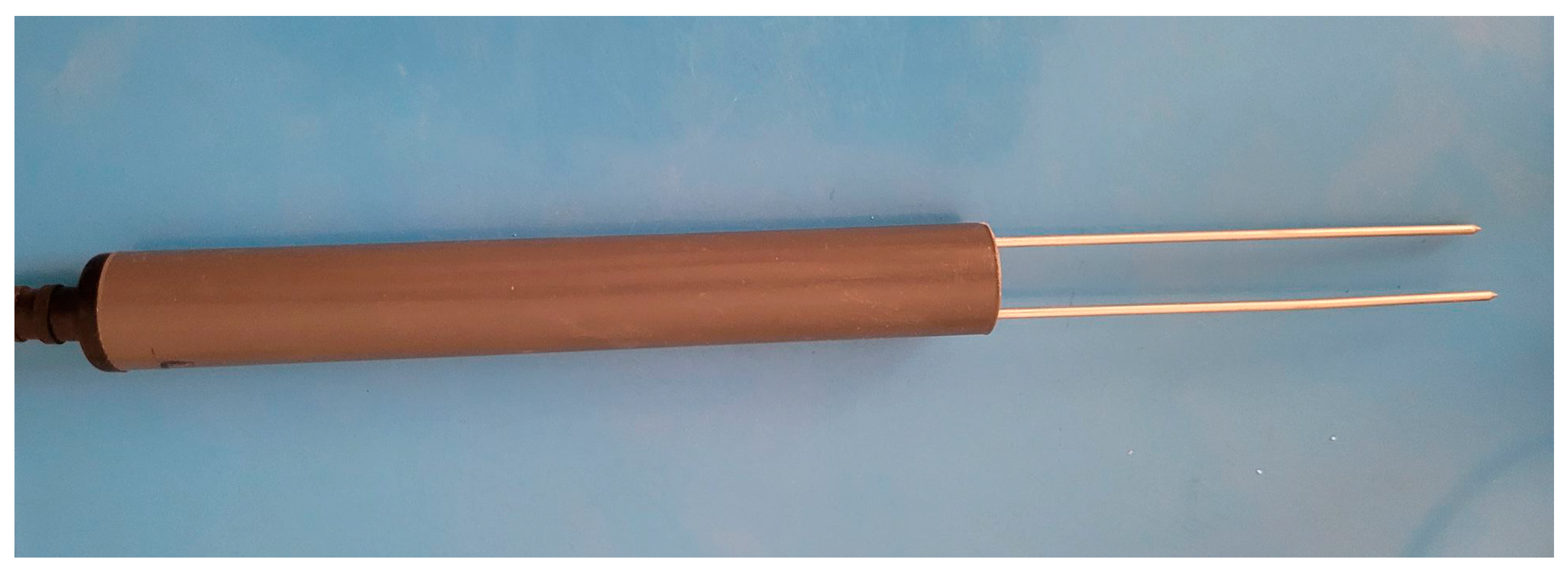
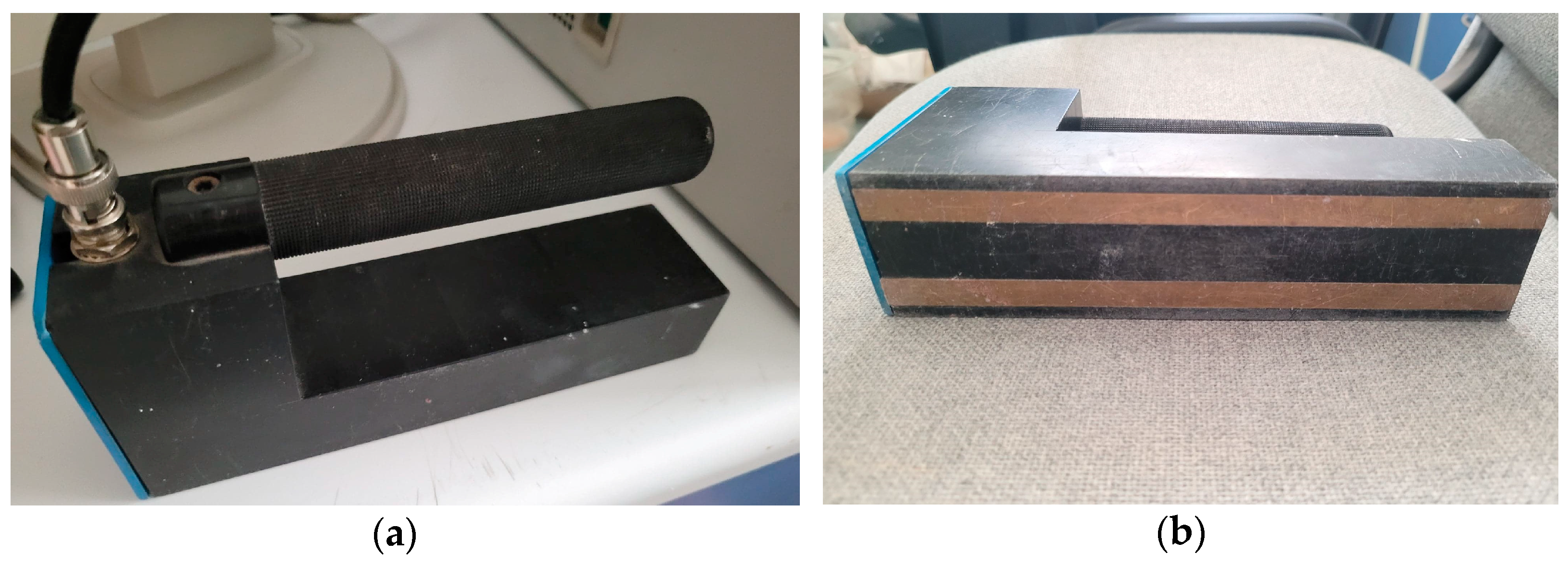
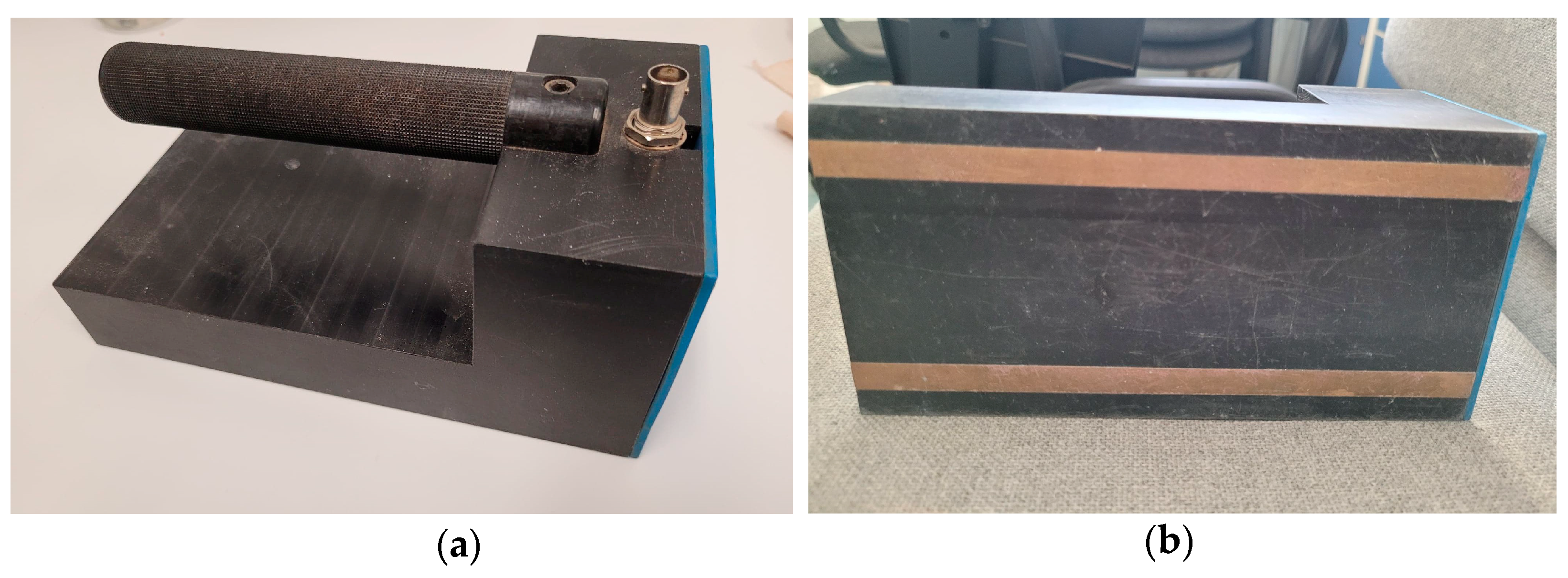
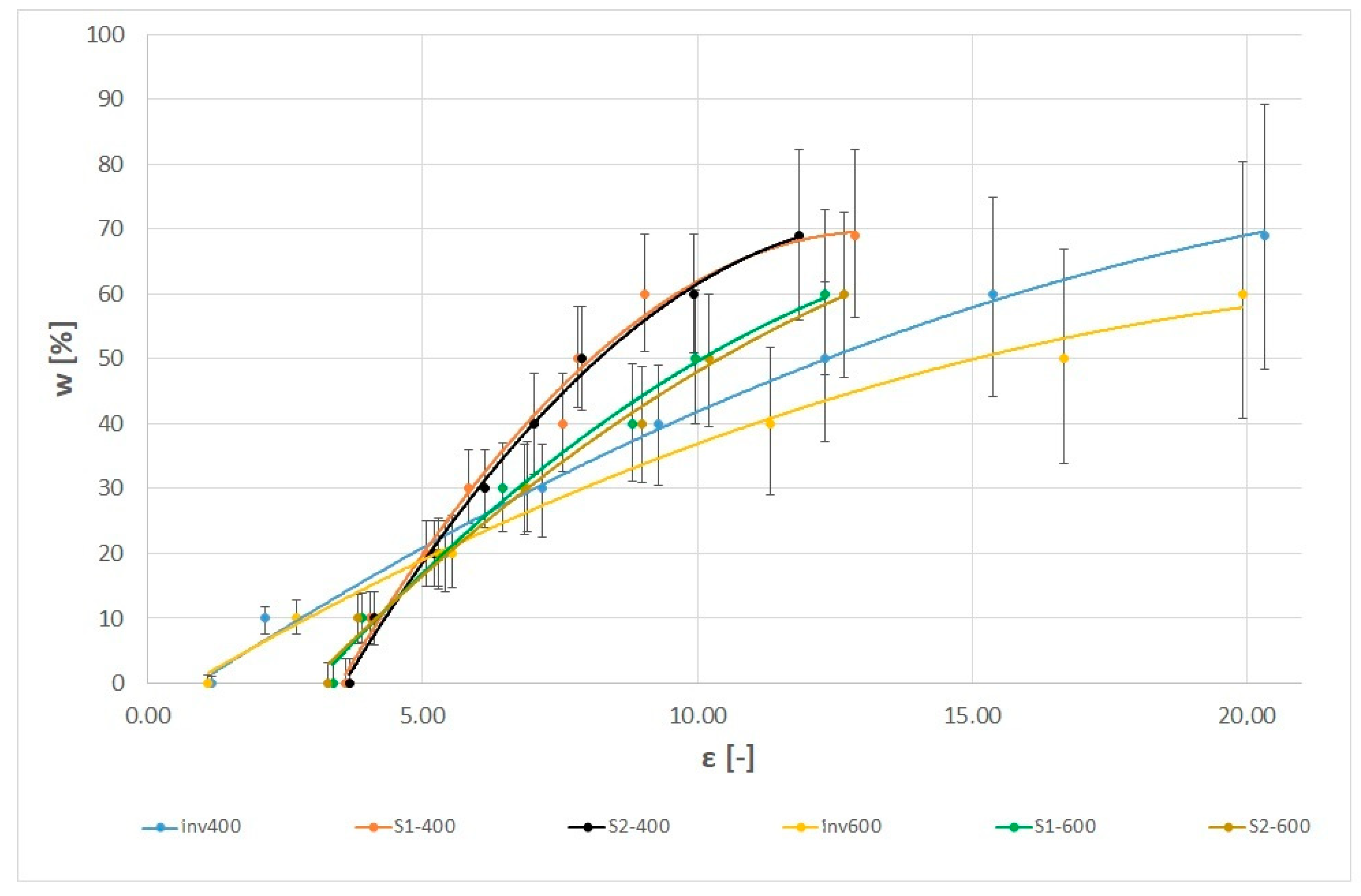
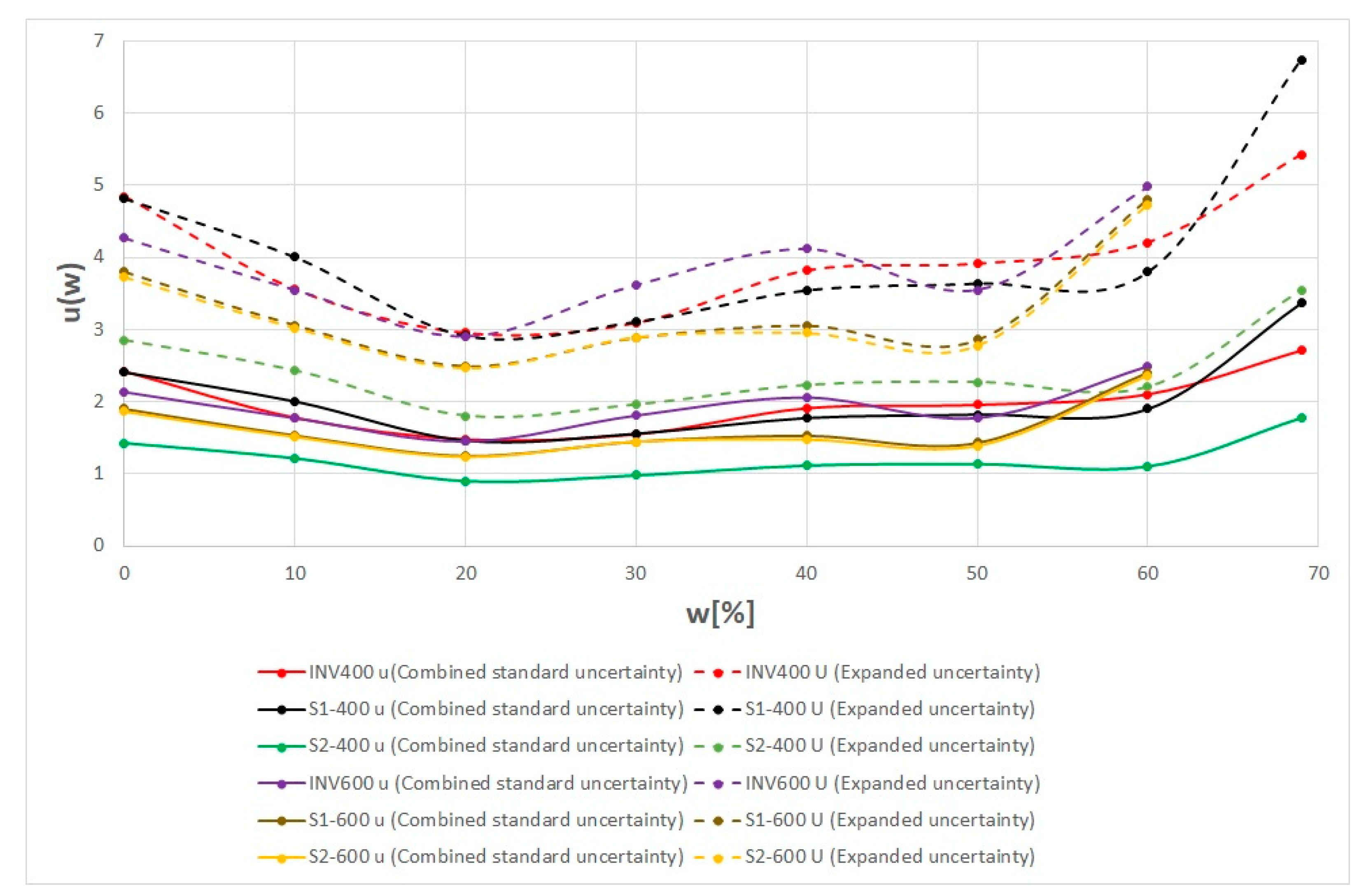
| Moisture w [%] | Apparent Permittivity ε [-] | ||||
|---|---|---|---|---|---|
| ε1 | ε2 | ε3 | ε4 | ε5 | |
| 0 | 1.18 | 1.16 | 1.14 | 1.2 | 1.18 |
| 10 | 2.14 | 2.01 | 2.22 | 1.84 | 2.41 |
| 20 | 5.31 | 5.82 | 5.09 | 5.42 | 5.47 |
| 30 | 7.17 | 6.87 | 7.55 | 7.25 | 7.02 |
| 40 | 9.32 | 9.47 | 9.37 | 9.27 | 9.07 |
| 50 | 12.54 | 11.91 | 12.35 | 12.01 | 12.78 |
| 60 | 15.55 | 15.38 | 14.84 | 15.83 | 15.26 |
| 69 | 20.35 | 20.27 | 20.33 | 20.55 | 20.11 |
| Moisture w [%] | Apparent Permittivity ε [-] | ||||
|---|---|---|---|---|---|
| ε1 | ε2 | ε3 | ε4 | ε5 | |
| 0 | 3.63 | 3.73 | 3.54 | 3.44 | 3.65 |
| 10 | 4.06 | 3.97 | 4.05 | 3.921 | 4.17 |
| 20 | 5.00 | 5.09 | 5.05 | 5.09 | 5.09 |
| 30 | 6.05 | 6.00 | 6.05 | 5.67 | 5.43 |
| 40 | 7.54 | 7.53 | 7.42 | 7.77 | 7.48 |
| 50 | 7.98 | 7.54 | 7.81 | 7.77 | 7.95 |
| 60 | 8.94 | 9.13 | 9.07 | 8.88 | 9.21 |
| 69 | 12.92 | 13.16 | 12.92 | 12.64 | 12.71 |
| Moisture w [%] | Apparent Permittivity ε [-] | ||||
|---|---|---|---|---|---|
| ε1 | ε2 | ε3 | ε4 | ε5 | |
| 0 | 3.56 | 3.59 | 3.67 | 3.79 | 3.71 |
| 10 | 4.18 | 3.88 | 4.01 | 4.25 | 4.28 |
| 20 | 5.38 | 5.16 | 5.34 | 5.02 | 5.20 |
| 30 | 6.04 | 6.24 | 5.90 | 6.38 | 6.17 |
| 40 | 7.26 | 7.30 | 6.84 | 6.69 | 7.10 |
| 50 | 8.31 | 7.86 | 7.69 | 7.69 | 7.96 |
| 60 | 9.62 | 9.56 | 10.22 | 10.22 | 10.09 |
| 69 | 12.25 | 11.86 | 11.53 | 11.67 | 11.88 |
| Moisture w [%] | Apparent Permittivity ε [-] | ||||
|---|---|---|---|---|---|
| ε1 | ε2 | ε3 | ε4 | ε5 | |
| 0 | 1.06 | 1.07 | 1.11 | 1.22 | 1.04 |
| 10 | 2.75 | 2.38 | 2.91 | 2.83 | 2.64 |
| 20 | 5.48 | 5.21 | 5.84 | 5.49 | 5.65 |
| 30 | 6.74 | 7.20 | 6.91 | 6.59 | 7.07 |
| 40 | 11.45 | 11.31 | 10.94 | 11.24 | 11.67 |
| 50 | 16.57 | 16.24 | 16.97 | 16.85 | 16.78 |
| 55 | 19.20 | 20.41 | 19.48 | 20.30 | 20.21 |
| Moisture w [%] | Apparent Permittivity ε [-] | ||||
|---|---|---|---|---|---|
| ε1 | ε2 | ε3 | ε4 | ε5 | |
| 0 | 3.33 | 3.42 | 3.25 | 3.32 | 3.50 |
| 10 | 3.82 | 4.05 | 3.94 | 3.88 | 3.77 |
| 20 | 5.27 | 5.44 | 5.28 | 5.29 | 5.20 |
| 30 | 6.27 | 6.58 | 6.50 | 6.39 | 6.58 |
| 40 | 9.05 | 8.79 | 8.58 | 8.83 | 8.85 |
| 50 | 9.78 | 10.27 | 9.82 | 10.05 | 9.84 |
| 55 | 12.05 | 12.25 | 12.31 | 12.62 | 12.35 |
| Moisture w [%] | Apparent Permittivity ε [-] | ||||
|---|---|---|---|---|---|
| ε1 | ε2 | ε3 | ε4 | ε5 | |
| 0 | 3.11 | 3.32 | 3.27 | 3.31 | 3.43 |
| 10 | 3.72 | 3.76 | 3.87 | 3.94 | 3.84 |
| 20 | 5.11 | 5.24 | 5.42 | 5.30 | 5.36 |
| 30 | 6.75 | 6.81 | 6.99 | 6.85 | 6.86 |
| 40 | 8.82 | 8.96 | 9.10 | 9.12 | 8.96 |
| 50 | 10.53 | 10.28 | 10.05 | 9.96 | 10.18 |
| 55 | 12.65 | 12.49 | 12.88 | 12.72 | 12.57 |
| Sensor | β1 | β2 | β3 | R2 | F Statistic | RSE [%mass] | RMSE [%mass] |
|---|---|---|---|---|---|---|---|
| Invasive | −0.098 ** | 5.660 *** | −5.005 | 0.994 | 419.593 *** (df = 2; 5) | 2.212 | 1.748806 |
| Non-invasive (S1) | −0.733 ** | 19.419 *** | −58.949 *** | 0.986 | 174.069 *** (df = 2; 5) | 3.42 | 2.703889 |
| Non-invasive (S2) | −0.684 ** | 18.86 *** | −58.64 *** | 0.996 | 555.122 *** (df = 2; 5) | 1.925 | 1.521514 |
| Sensor | β1 | β2 | β3 | R2 | F Statistic |
RSE [%mass] |
RMSE [%mass] |
|---|---|---|---|---|---|---|---|
| Invasive | −0.127 ** | 5.482 *** | −4.827 | 0.993 | 286.774 *** (df = 2; 4) | 2.089 | 1.579467 |
| Non-invasive (S1) | −0.458 * | 13.056 ** | −36.376 ** | 0.990 | 191.525 *** (df = 2; 4) | 2.552 | 1.929395 |
| Non-invasive (S2) | −0.379 * | 11.670 ** | −31.802 ** | 0.990 | 555.122 *** (df = 2; 5) | 2.509 | 1.896724 |
Disclaimer/Publisher’s Note: The statements, opinions and data contained in all publications are solely those of the individual author(s) and contributor(s) and not of MDPI and/or the editor(s). MDPI and/or the editor(s) disclaim responsibility for any injury to people or property resulting from any ideas, methods, instructions or products referred to in the content. |
© 2023 by the authors. Licensee MDPI, Basel, Switzerland. This article is an open access article distributed under the terms and conditions of the Creative Commons Attribution (CC BY) license (https://creativecommons.org/licenses/by/4.0/).
Share and Cite
Paśnikowska-Łukaszuk, M.; Wlazło-Ćwiklińska, M.; Zubrzycki, J.; Suchorab, Z. Comparison of Measurement Possibilities by Non-Invasive Reflectometric Sensors and Invasive Probes. Appl. Sci. 2023, 13, 665. https://doi.org/10.3390/app13010665
Paśnikowska-Łukaszuk M, Wlazło-Ćwiklińska M, Zubrzycki J, Suchorab Z. Comparison of Measurement Possibilities by Non-Invasive Reflectometric Sensors and Invasive Probes. Applied Sciences. 2023; 13(1):665. https://doi.org/10.3390/app13010665
Chicago/Turabian StylePaśnikowska-Łukaszuk, Magdalena, Magda Wlazło-Ćwiklińska, Jarosław Zubrzycki, and Zbigniew Suchorab. 2023. "Comparison of Measurement Possibilities by Non-Invasive Reflectometric Sensors and Invasive Probes" Applied Sciences 13, no. 1: 665. https://doi.org/10.3390/app13010665
APA StylePaśnikowska-Łukaszuk, M., Wlazło-Ćwiklińska, M., Zubrzycki, J., & Suchorab, Z. (2023). Comparison of Measurement Possibilities by Non-Invasive Reflectometric Sensors and Invasive Probes. Applied Sciences, 13(1), 665. https://doi.org/10.3390/app13010665








